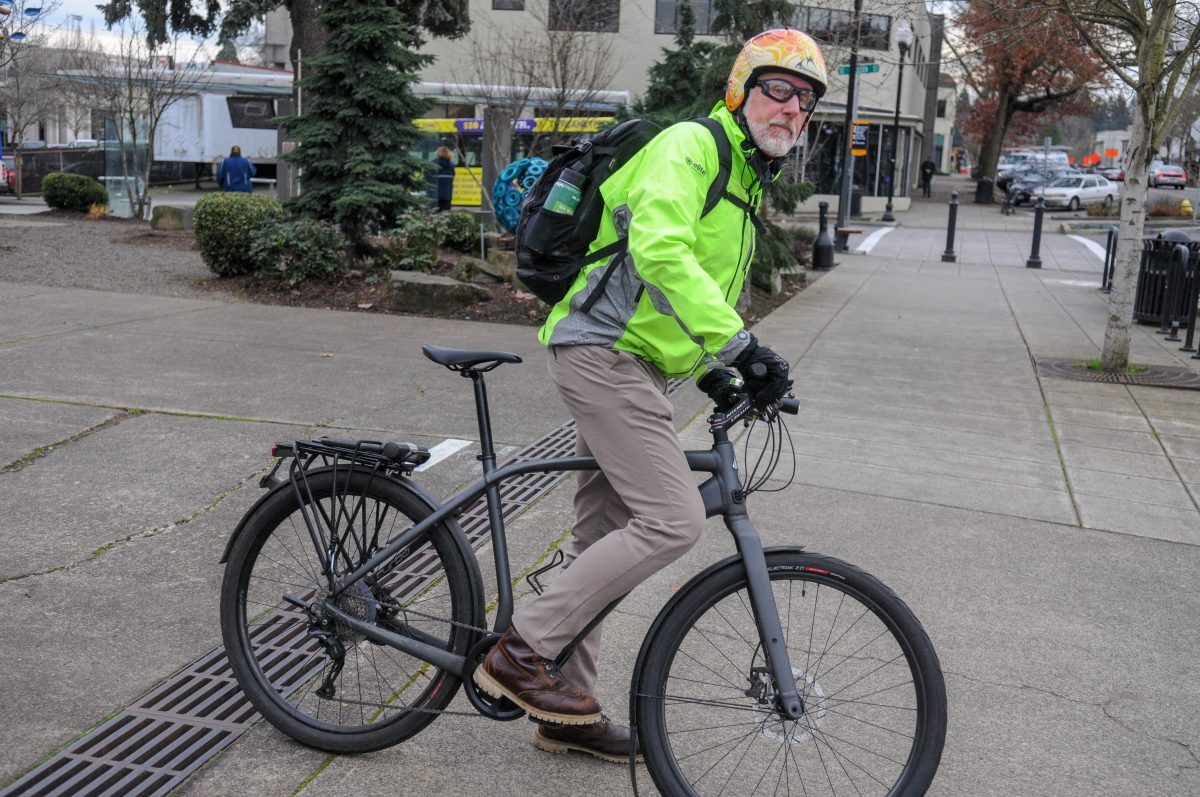
(Photos: Jonathan Maus/BikePortland)
Surprisingly, the loudest political voice for bicycling in our region doesn’t come from Portland City Hall. It comes from a city hall six miles south of Portland in Milwaukie, in the office of Mayor Mark Gamba.
One reason Gamba has emerged as a leader on transportation reform is that he probably logs more miles on a bicycle than all other regional elected officials combined (and yes, it matters). In the past few years I’ve noticed Gamba and his sleek, matte black, Specialized Vado e-bike at meetings and events that are often more than a dozen miles from his office. The other reason cycling is front and center for Mayor Gamba is because it ticks all the boxes when it comes to his highest policy priority: climate change. A former National Geographic photographer, Gamba told me during an interview last month that observing wildlife through his camera lens has given him the urgency to save it.
Gamba is the rare Oregon politician who isn’t afraid of the word “bike”. In fact, he embraces it.
During my time with Gamba we talked about his focus on climate change, his work to make Milwaukie a nicer place to walk and bike, his push for transportation reform across the region — and the politics it takes to make it happen. And of course, we got out on our bikes for a ride around town.
My conversation with Mayor Gamba is below. It’s been edited for brevity and readability…
What’s your relationship to cycling?
“Every time there’s a transportation conversation, I’m saying, ‘Look, it’s far cheaper to build another Springwater Corridor than it is to add a lane to I-205.'”
“I grew up biking. I biked to school ever since I was a 7th grader in Western Colorado. I rode a [standard, non-electric] bike when I was a city councilor; but then I stopped when I got too busy as mayor. About five years ago my girlfriend started bicycling from Milwaukie, up through Riverview Cemetery to Lake Oswego. It took her one-and-a-half hours. She said, ‘I can’t do this. It’s too much.’ A friend of hers had an e-bike, so she borrowed it and cut her commute down to 45 minutes — rain, shine, no matter what. That’s faster than a car in some conditions! So I was like, ‘Yep! I’m going to get one.’ Now that I have one, I’m back to riding to about 90 percent of my meetings.”
What do you like about the e-bike?
“It’s astonishing how much faster it is. [In November of last year, Gamba challenged conservative talk radio host Lars Larson to a race between Portland and Milwaukie city halls. Larson never responded.] Plus, I used to show up to meetings sweaty, especially in the summer. Now, as mayor I’ve got a bit higher expectations, so with the e-bike I can just throw my sport coat in a pack and put on a rain jacket and some rain paints. I can walk into a meeting, pull off my rain pants and jacket, put on my sport coat, and I’m ready to go. Then I can sit back and hear everyone else bitch about their terrible drive to the meeting.”
So you want everyone in the room to know you biked there?
“What I’m trying to do is illustrate that you can bike and still show up looking professional. That’s my thing. So I make sure I always walk in with the soaking wet rain jacket on and a helmet. Then I take it off and lay it on a chair, then I put on my sport coat and then I’m in the meeting. Half of the mayors in the region joke with me about it.”
Does the fact that you arrive by bike change the conversation?
“It’s becoming enough of a thing that they won’t sit in the same meeting as me and say things like it’s infeasible to put in bikeways. I don’t know how much affect I’m having personally, but Clackamas County went from downgrading the proposed bike/ped bridge across the Willamette between Oak Grove and Lake Oswego — they downgraded it to a level where it wouldn’t receive funding even though it got the most supportive comments from the public by orders of magnitude — but just recently they not only upgraded it but they supported a grant to study the project and the one Republican on the [Clackamas County] commission has become one of its new champions. That’s a major shift in just three years.
So yes, I think it’s shifting. I took a whole bunch of people from JPACT and MPAC [Metro transportation advisory committees] on a ride when the e-bike show was in town a few years ago. 25 of them showed up. And one Metro councilor went out and bought an e-bike after that. It was Kathryn Harrington, who was just elected Chair of Washington County. Mayor Jeff Dalin of Cornelius was on the ride too. He rides a motorcycle typically, and he had a blast! He smiled and laughed the whole time. It was a real eye-opener for a lot them.”
What have you done to make changes on the ground in your own backyard here in Milwaukie?
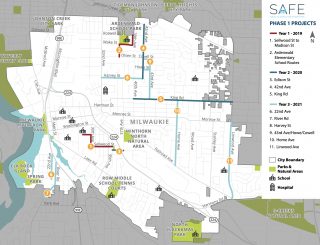
(City of Milwaukie)
“SAFE – Safe Access for Everyone, is a planning process I started as city councilor after I heard parents from Linwood School testify before the planning commission. They said, ‘Our kids live five blocks from the school and they can’t walk there safely.’ They were really passionate about it. So I met with them to learn more. Then I went to a budget committee meeting and said we need to start building sidewalks in the neighborhoods. At the time, we only had a handful outside of downtown. They said, ‘We should study that.’ Well, it turned out the city had already done a study 10 years ago and found it would cost $30 million. And the councilors at the time were like, ‘Oh, we could never do that.’ So the plan just sat on the shelf. That next fall elections were coming up, so I went out and recruited two women to run against two of the councilors who were up for election. One of the women was Karin Power [currently an Oregon House Representative], the other was Lisa Batey. They both won. Beat them badly. I was done with those guys. They weren’t doing the things we should have been doing for our city.
The next step was to overhaul PSAC, our Public Safety Advisory Committee. Theoretically, is was in charge of public safety, which includes transportation; but they were really just a cheerleading squad for the police. So I slowly started replacing the members with young parents who were advocates for active transportation. Once we reached a critical mass on that, the Council had made the decision to do something about the issue, so I said, let’s assign PSAC to do a planning process. And that caused the rest of the older PSAC members to quit, and I was able to fill those seats with more young parents.
By the time the SAFE plan came back to City Council for approval in 2014, the whole city was behind it. Everyone was excited about it. Then we had to figure out how to pay for it. We don’t have a lot of growth in Milwaukie. We’re not getting fresh tax dollars. So this city gets poorer every year. It’s about $51 million to do all the SAFE projects. We knew we couldn’t raise $51 million, so we did some math: $4.85 per month on everybody’s water bill (with an exception for low-income people and a different rate for businesses) and we went out and bonded against the first phase of projects. Council passed it. And when that first water bill came out we only got about five or six angry phone calls.”
When will these projects get built?
“Some of them already have concrete being laid. The first phase started this last spring.”
Advertisement
Has Milwaukie adopted Vision Zero?
“I proposed that years ago, and I have one councilor — Lisa Batey — who has this thing about setting goals that can’t be attained. It’s like an embarrassment thing. She believes in all these initiatives though, just not in the proclamations. It was the same with climate. She pushed back on that. I pushed for Milwaukie to be a “Net Zero City” by 2040 and she said, “That’s impossible! We can’t do it!” But it’s an official city goal now because we did a visioning process around it and citizens pushed for it .
And as for Vision Zero, we’re doing all this stuff anyways. And the places that are the worst for Milwaukie as far as deaths and serious injuries are concerned, are where we cross Highway 99 and 224 — which are ODOT roads we have virtually no control over.
When you look at regional maps for deaths and serious injuries, 99E is one of the routes, top to bottom, that’s bad — with the exception of one spot in the middle. Guess where that is? That’s Milwaukie. It’s because we have a lower speed limit through downtown. It makes a huge difference.”
Do you see Milwaukie as a bridge between the reform-minded transportation mindset in Portland and the sometimes anti-Portland, “No Portland creep” mindset in Clackamas County?
“Yes. I do see us as a bridge. I see us as setting an example at Clackamas County. I’m not shy at C4 (Clackamas County Coordinating Committee) meetings. Every time there’s a transportation conversation, I’m saying, ‘Look, it’s far cheaper to build another Springwater Corridor than it is to add a lane to I-205. You guys want to start solving congestion? Make it safer for people to ride their bikes everywhere in this region.’ And I say that over and over and over again. I push really hard.”
How is cycling related to the other issues you’re working on?
“When you’re sitting in that little coffin, driving down the street, you are completely oblivious to the rest of the world.”
“For me, this is all about climate. That’s what drives me. I was a National Geographic photographer. I was seeing climate change happening and I understand what that looks like when it plays out. It’s very clear in my head what this world looks like if we don’t turn this thing around. And what it looks like is a place that’s untenable for human beings — certainly untenable for the society we’ve created. So that’s why I got into politics in the first place. And I understand that single-occupancy, gas-powered vehicles are one of the biggest problems in that realm. The more we can pull people out of those cars it’s better for health, and our community because you run into people and you talk. When you’re sitting in that little coffin, driving down the street, you are completely oblivious to the rest of the world. You don’t know what it smells like, you can’t hear the sounds, there’s no interaction. You are literally moving from your home, into another indoor space, into your office (another indoor space). And I feel like active transportation is better for people in all ways. And bicycling is the most efficient form of transportation humankind has yet developed.”
Have you found a way to say all that without scaring other policymakers away?
“I don’t know. I haven’t discovered a secret for being able to translate to a climate denier why this makes sense. Although I have had conversations with some of those people who are not total whack-jobs, ones who are just to the side of that, and said, ‘Look, if we pull 10,000 people out of their cars and onto bikes, that’s 10,000 more spaces on the freeway for you.’ And they can hear that. They have a hard time imagining that there’s 10,000 people that want to ride their bikes. So I think that’s part of the thing we need to continue as a movement: Make it really clear that there are a lot of people that want to ride, that there are a lot of people that would love to ride their bikes if they felt like it was safe, if they felt like they could get there without getting soaked or being sweaty or smelly or taking too long, or all those things. It’s a learning process.”
You’ve been a leader here for nearly four years now. What’s the status of cycling in Milwaukie?
“It’s picking up. We had a developer having a meeting standing outside city hall a few months ago and he asked one of our staff, ‘How bike friendly is Milwaukie?’ And coincidentally I was riding up into city hall to park my bike. And she goes, ‘That’s the mayor.’
I see more and more cycling in Milwaukie and we haven’t even done the things we have planned yet. None of these greenways [on the SAFE map] are built. I see cyclists all the time now. When I first moved here 16 years ago, I was it… well me, and Matt Menely [local bike advocate] and a handful of other crazies.”
What have you built for cycling here in the last 3-4 years?
“The new path on 17th Avenue is the only thing that’s been built. Monroe has sharrows [and is slated for much bigger things as the city’s primary greenway]. We’re putting in a diverter at Linwood to bring the traffic level down so it’s a reasonable greenway.”
Speaking of that 17th Avenue path. What happened with those terrible stop signs? [When the path was built there were many stop signs directing bicycle riders to stop at private residential driveways.]
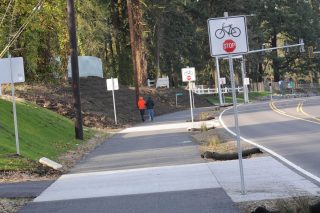
“We were a week away from me going out there and pulling them down myself! The ODOT engineer is in control of that aspect of any new bike infrastructure they are in charge of. So whenever you have that type of grant money – unless you’re Portland or Clackamas County or Eugene, places that have a federally qualified engineer — you have to work with ODOT. And the ODOT guy who’s in charge of the signage, his attitude is every place you cross anything where a car can drive, you need a stop sign. I told my engineer: ‘Here’s what’s going to happen: We’re going to have an opening day ride and I’m going to lead that ride, and I’m going to stop at every single one of those stop signs. Then I’m going to explain to everyone, ‘Yep, that’s ODOT.” And a couple weeks later, the stop signs came down. It still frustrates me, even when the path crosses streets [two stop signs remain] because, if you think about it, if it was a bike lane, those cars would be required to stop for 17th Avenue traffic, which includes bicycles. So my personal attitude is, the bicyclists should have free-flow, just like the cars on 17th do.
Idaho has that rolling stop thing. I think Oregon needs to get on the stick. Now that we have a supermajority [in the Oregon Legislature], it might be the time to go after some of this bullshit that bicyclists have to deal with.”
In 2017 the legislature passed a $5.3 billion transportation package that included a bunch of highway expansions that felt like giveaways to Republicans so Democrats could get relatively small investments for other things likes transit and safe routes to school. The 2020 Metro transportation bond is going to happen and I’m worried we’re following that same path. How do you feel about that? When this bond comes up, will you still be at the table talking strongly about bicycling investments?
“Absolutely. Where I struggle — and I do struggle — is when they talk about widening I-205, I’m like, ‘Great, and we build that new lane and guess what, demand responds. It fills back up!’ So instead of having a traffic jam for six miles, you have a traffic jam from the Oregon border down past Wilsonville. It’s induced demand. So I struggle with that because I understand people. They see all the traffic as the problem and it’s really hard to convince them that, so did Denver and so did Los Angeles and so did Dallas and so did Atlanta — and they kept building more and more and more lanes and they all filled up. That’s not the answer. I’m finally getting other mayors to hear that. [Wilsonville Mayor] Tim Knapp has been arguing that we’ve got to be building mass transit if we’re building a lane on I-205, it’s got to be set up to have buses on shoulders, those kinds of things. So it’s starting to shift. People are starting to hear it.”
If you had a vote, would you have voted for the I-205 widening project?
“It’s really hard to point fingers and say, ‘They failed’. But they did.”
“Well [large exhale]… I think… I mean… I’m not down there, so it’s really hard to point fingers and say, ‘They failed’. But they did. And the politics is about the fear of backlash. Here’s what all of those people [electeds in Salem] fear: They go, ‘OK, If we do all the things that you’re saying we should do, and we piss off 70 percent of the populace, guess what you’re going to have? You’re going to have a Republican legislature again.’ And I’m like, ‘Well, what we’re getting on on the ground is not much different than what we’d be getting if we had a Republican legislature.’ Then they kind of cringe, and they hear what I’m saying. It’ll be interesting to see what happens with this supermajority. With people like [Senator] Shemia [Fagan] and [Representative] Rachel [Prusak]. They’re real go-getters.”
We still have these three freeway widening projects on the books. What do you think people should do about them? Should we fight? Should we just move on? Will you be part of the opposition?
“I would definitely weigh in… [long silence]… You always have to step in and look at the big picture. When you recognize that there are a 1,000 people a week moving into the region. When you really wrap your head around that and imagine how much worse the congestion is going to get. To some degree, we have to do everything. But my argument is this: We can get a whole lot more people out of cars and onto bikes with “X” amount of money than you can change the dynamic of a freeway with that same amount of money. Pound for pound, dollar for dollar, you’re going to do much better spending on bike infrastructure. And that’s the drum I’m going to continue to beat.
I’m not necessarily going to lay myself across Highway 217 and try and stop that project. But I will continue to say we have to be spending equally, at least, on bike/ped. Because that’s how you’re truly going to get a shift in congestion. You are not going to get a shift in congestion by building lanes on highways. Building more lanes doesn’t work.”
Do you think Portland is headed in the right direction?
“I see cities that aren’t green bubbles like Portland doing really huge things. Like Indianapolis [they completed their downtown Cultural Trail in 2013]. I actually think Portland is a little behind the times. We haven’t invested to the level that some of the other cities have invested in our bike infrastructure. And we could. And I’m really hoping — because she’s such a climate hawk — that our new Metro President Lynn Peterson will drive that.”
———
Gamba won a second term as mayor in November (he ran unopposed) and told me he plans to seek higher office someday. When ODOT Director Matt Garrett resigned last month, Gamba posted on Twitter that he hopes Garrett’s replacement is a “climate hawk”. I semi-jokingly asked Gamba if he’d be interested in the ODOT job. “Wow,” he replied. “I hadn’t really considered that, I’m kind of on a different path. Hmmmm.”
— Jonathan Maus: (503) 706-8804, @jonathan_maus on Twitter and jonathan@bikeportland.org
Never miss a story. Sign-up for the daily BP Headlines email.
BikePortland needs your support.


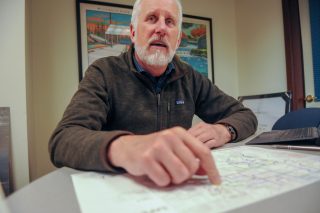
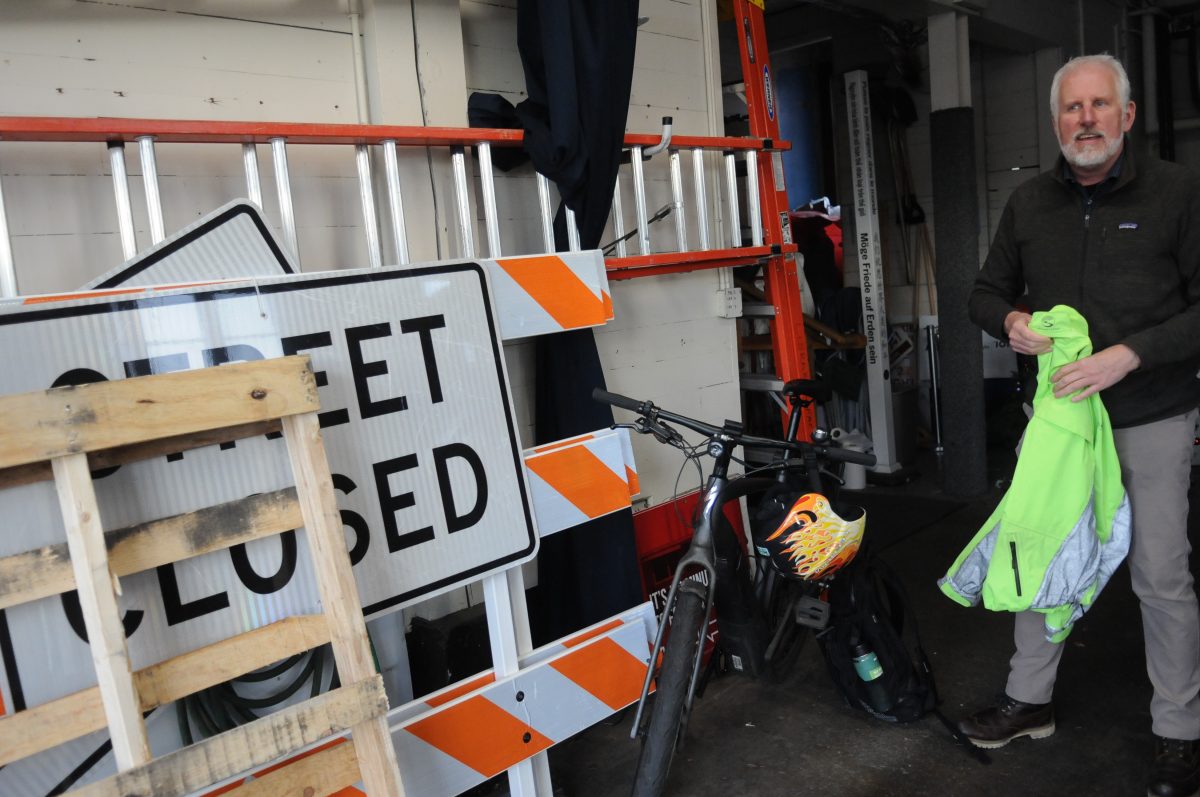


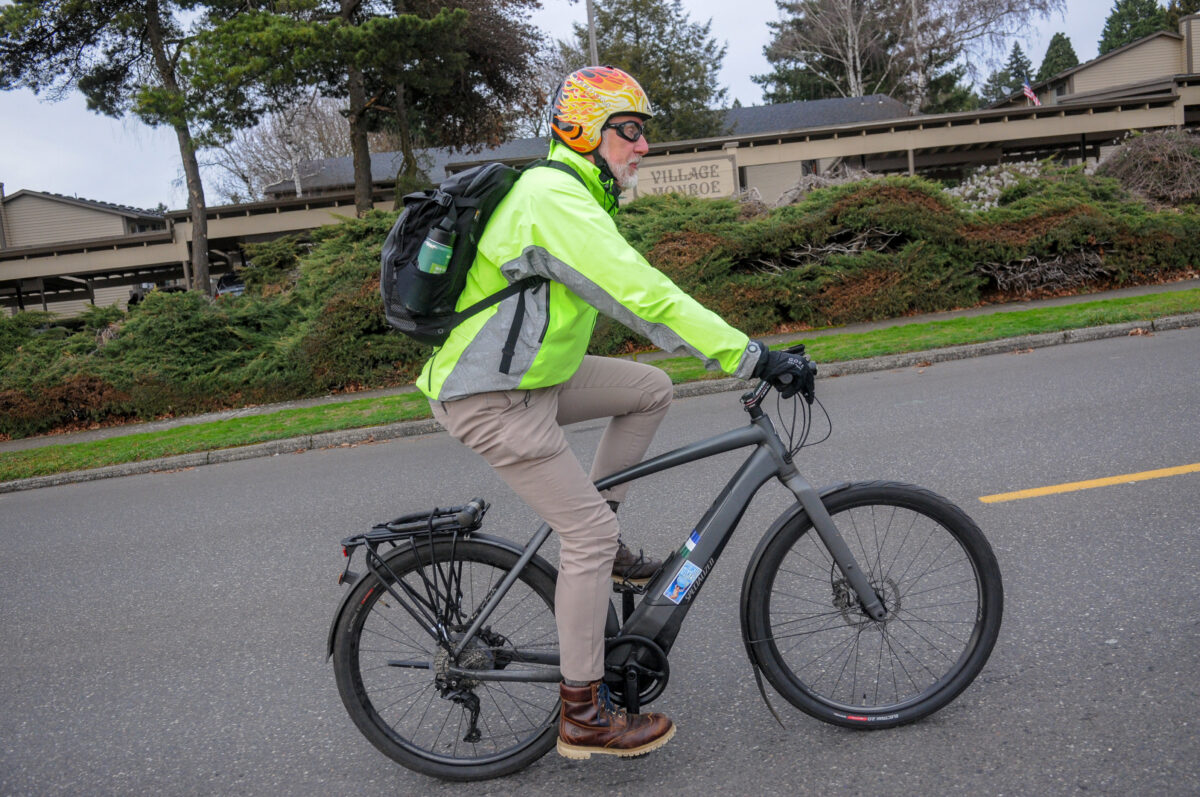
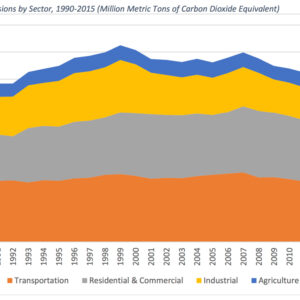
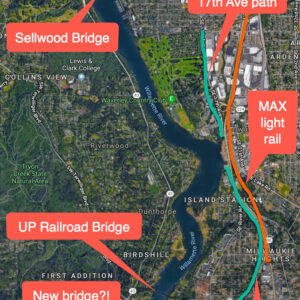
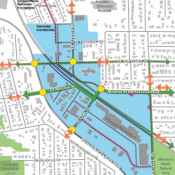
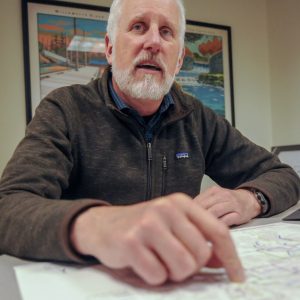
Thanks for reading.
BikePortland has served this community with independent community journalism since 2005. We rely on subscriptions from readers like you to survive. Your financial support is vital in keeping this valuable resource alive and well.
Please subscribe today to strengthen and expand our work.
This is one of the most pro Idaho-Style stop law statements I have seen from a politician in Oregon in awhile and it is really refreshing. If Mark would like to know more about the history of attempts to change the law here I would be happy to pull something together and sit down with him. Not many people seem to realize that Idaho is no longer the only state that has a stop as yield law for cyclists as Delaware also passed it in 2017. It appears that it has worked fine there just like in Idaho.
I’d love to sit down with you. Email me and let’s find a time: gambam@milwaukieoregon.gov
Jonathan, I believe there is still a bicycle stop sign at a residential driveway at SE McBrod Ave(?) I rode the 17th Multi-use path a few days ago and there’s still at least two signs there.
Oops you mentioned this, nevermind
I’m a Milwaukiean. Mayor Gamba was my inspiration for getting an e-bike to commute to downtown Portland a couple years ago– something I only considered after the 17th side path was installed. After falling in love with it and wanting to up my fitness, I switched to an analog bike. The e-bike is lonely now but I’ve never been in better shape, and I never would have had the courage or fitness to try it without the e-assist. I made up for the cost of the new bike in a little over a year of commute $ savings.
If you want to bike commute but can’t afford Portland, I am convinced there is no better place to live than the west side of Milwaukie. We do need some better east-west routes, but going north I only share the road with cars for a couple short stretches over a mostly flat 7 miles to downtown. I’ve been MAXing it this week and was rudely reminded of how much slower it is. And the $25 I spent could have bought me the pair of warmer gloves I need to be able to ride in the cold!
Has anybody done the math? With the amount of money being spent on the I-5 Rose Corridor freeway expansion ($ .5 Billion) we could fund the entire 2030 Bike Master Plan.
Thanks JM for the interview. Hopefully other electeds will read, and step up to the plate, to promote more active transportation infrastructure and promote active transportation as a viable option.
It can be a bit more complicated. The rules on spending gas tax money require that most of the money go towards highways and a smaller portion towards all other modes. The maximum allowed by the Feds is currently 20% towards bike/ped/transit and minimum to highways is 80% (here in NC it’s even worse, 90% towards highways and 10% towards all other modes, including our state-owned railway.) So even if your ODOT really wanted to spend all $500 million on bikeways instead of highways, they couldn’t legally do so. The most they could spend is $100 million of that, and they would likely have to return most of the remaining $400 million back to the feds, since the original earmark was for an all-highway project and not for bikeways.
Also keep in mind that only Oregon requires that all gas tax revenue collected, be it federal, state, county, or city, must the revenue go towards transportation projects. These fed rules on how federal gas tax revenue is spent are aimed chiefly at the other 49 states, who use their local and state gas tax revenue to fund schools, prisons, police, homeless shelters, governor mansion renovations, etc, as well as highways and bikeways. But the federal rules apply to Oregon just the same.
Let’s consider your analysis….
$100 million towards active transportation projects…that brings the city $100 million closer than they were initially on the Bike Master Plan build out.
$400 million left over…Perhaps a complete rebuild of 82nd Ave. (an estimated $400 million project), or perhaps Hwy 30 rebuild to include bike/ped infrastructure. What about Barbur Blvd.?
I can go on and on about other ODOT infrastructure that needs rebuilding that might qualify for state/federal funding if it were not earmarked for specific projects.
Complicated? Yes. Doable? Yes, with some political fortitude in Salem and downtown Portland.
Thanks, Jonathan. That’s a great interview.
There’s nothing like some actual time on a bike to understand bicycling and bicycling infrastructure.
I’ve often said in this forum that councilors, commissioners, cops, ODOT managers and engineer, and DA’s need to spend a little time on a bike before making policy and technical decisions about bicycling. From what I have seen, very few do so. Mayor Gambra should be in inspiration for all of them and for us.
Can we get some more of him please? Better yet can we get him to take on Multnomah Co. roads and show them why their neglect of anything other than SOV’s is such a problem?
Great interview, JM – very encouraging. Best of luck to Mark, may
may he stay the course!
“She believes in all these initiatives though, just not in the proclamations.”
Lisa Batey is not wrong. It *IS* embarrassing to make a proclamation and then refuse to spend the effort and money to see it through. It’s going to be tragicomedy to see how Portland and Metro attempt to excuse/spin their lack of progress in the next climate action plan update.
“Idaho has that rolling stop thing. I think Oregon needs to get on the stick. Now that we have a supermajority [in the Oregon Legislature], it might be the time to go after some of this bullshit that bicyclists have to deal with.”
Thanks for calling it what it is, Mayor Gamba. (Delaware and parts of Colorado also have the Idaho Stop.)
“I’m not necessarily going to lay myself across Highway 217…”
With all due respect, that does not come across as climate hawkish.
“I actually think Portland is a little behind the times.”
Understatement.
I agree we should be cautious with “audacious” goals, only because if you set a goal and then keep missing it year after year, it just normalizes the idea that goals are something that you miss year after year.
I would start by observing that setting audacious goals is a good place to start if only because that captures how far out of whack things have gotten, how far we must go to right this ship. Which brings us to the second matter of meeting or failing to meet these audacious goals. But why look at this in such a binary manner? Surely those two imaginary end points aren’t that helpful, aren’t very good approximations of what we will accomplish along the way.,We are almost certainly going to end up somewhere in between, and if we demand some accountability from thise we put into positions of power our chances of eventually getting there seem pretty good.
Our problem isn’t, by and large, setting and then failing to meet audacious goals; it is giving up before we even try.
He should be Portland’s mayor!
You spelled President and America wrong.
He’s got my vote!
Governor of Oregon.
This is, hands down, the most inspirational interview with an elected official I’ve seen in years! I would love to see Mark as the Portland mayor, but I bet he’s too smart to want that heartache – better to be somewhere where he can actually catalyze some meaningful change.
Portland feels like an ungovernable city. Or is it just our incapable city government?
Neither and both. Portland has had the same type of legislative body for about 100 years, from when it was a town of 10,000 or so, trying to manage a city of 650,000. You directly elect your city manager and 4 assistant city managers (mayor and commissioners), all of whom are amateurs who are required to learn-on-the-job. As a consequence, each bureau is effectively its own little (and not so little) fiefdom, ruled by a director and his or her staff, able to wield a certain degree of power, but not in any coordinated fashion, certainly not towards any of your common goals. All on a budget that is half of what you really need in a community the refuses to raise its taxes to pay for what is needed. You can blame your government and your council, and most people do, but I blame the governed as they seem to have tolerated this state of affairs for so long.
Can we crowd fund a site so Mr.Gamba can relocate and run for Portland Mayor?
No, you can’t have him. Get your own!
Go straight to governor please. Most of our transportation problems are best fixed at the state level.
“I have one councilor — Lisa Batey — who has this thing about setting goals that can’t be attained. It’s like an embarrassment thing.”
We have a few of those folks here too, among the commenters.
Refusing to set a goal is probably the most promising way to not attain it.
Some people!
Let’s get real. Most things worth striving for are unattainable in the absolute. Equality? Living wage? Bikes for everyone? Leaving fossil fuels in the ground? Fortunately we have plenty of people who persist, who keep up the pressure, who refuse to take no for an answer.
True. I’m no longer content to provide political cover for unfunded goals that collect dust on city shelves.
And in direct response to Mayor Gamba’s comment about Portland, the 2009 Bike Plan is a terrific example of this:
https://www.portlandoregon.gov/transportation/44597?a=379136
By essentially every measure, Portland has failed to implement its 2009 bike plan. This failure has been so total that the city long ago stopped highlighting its bicycle count metrics. They now exist as a hard to find embarrassing google doc that shows how cycling peaked around 2011, plateaued until around 2014, and has seen a modest decline since then.
https://docs.google.com/spreadsheets/d/1urP-ZA0Pd25_JZZ18hkGPlDEUQusBp49XmLzwpZ-2ag/edit#gid=0
awesome “When you’re sitting in that little coffin, driving down the street, you are completely oblivious to the rest of the world.”
I started working in – and biking to – Milwaukie about six months ago. I am fortunate to work right next to the Springwater, but in the “industrial” area of Milwaukie on SE Ochoco. While the Trolley Trail is just up Ochoco on SE 17th and the Springwater is just up the berm on the other side of the road, Ochoco itself is a horrible and scary place to be a cyclist. it’s even worse as a pedestrian, as a big section of this road has no sidewalk and a small shoulder and lots of trucks. I realize Ochoco might be the border between Portland and Milwaukie, but to me it’s an example of where both cities have forgotten about the human element.
Jonathan–Something is wrong with your camera. I’m looking very, very carefully at those pictures of Mr. Gamba, and I still can’t see his cape. Please fix.
This is one of the best interviews with a politician I’ve read. As a fellow Milwaukian I’m glad he’s our Mayor!
No way this interview is real.
Love the creativity of having this fictional character challenging Lars Larson to a bike-vs.-car race during rush hour–priceless!
And the tricky touch of having “Mark Gamba” show up in the comments, responding to the first commenter that he’d “love to sit down” with the guy to talk about the Idaho stop… Yeah, right. I’m gullible but not that gullible!
Your article failed to mention the total disfunction Gamba brings to COM administration. How many staffers, managers, directors and engineers have quit during Gamba’s tenure? Please go back to your photographing and leave the leading to the adults.
Out with the old, in with the new? Perhaps it was time for a change.
I’d have to disagree. While there has been some turn over during his tenure, the largest amount of staff turn over was before Mark became the Mayor, during what I call ‘the Council of NO’. Mark and former Mayor Ferguson were in the Minority for several years and consistently outvoted by three guys who could not look to the future. That was a dark time for people who wanted positive change in Milwaukie and a number of residents worked behind the scenes with Mark to get Lisa and Karin elected so that things could turn around. Contrary to what some may be getting from this article, Milwaukie is still far from perfect but Mark is doing his best.
Sounds like you should strap on your boots and run for office. Be the change you want to see, citizen.
I was really encouraged to hear this perspective. I live and work in Oregon City and am the only cycling commuter in my building. Maybe once a week I’ll see another bike out there on my way to or from work. Out here I often feel lucky to have stripes of paint separating me from the commuters who use cars and I read the blog to maintain my optimism. To read such an perspective from a Clackamas County mayor is refreshing. Thanks Jonathan for reaching out to him.
This guy is my new hero. Must be a Sagittarius or an Aries, heh! I might move to Milwaukie just so I can vote for him. Property values are going to skyrocket shortly, like they always do in places that take this tact. Bike-friendly places, or at least not-car-dominated places, are high-value places where people want to live. Suddenly, whole and integral communities spring up around this one little thing, that is everything. The tax base won’t be small for long. He’ll be credited someday with bringing prosperity.
Arriving at meetings: I like to go even further, to the point of not-quite-but-almost concealing the fact that I arrived on a bike. Which I guess would translate in his case to walking in with the sport coat already on. Just to prove that I’m exactly equal to everybody there. But his way is better for bike PR than mine, because for them to have any idea that I biked there, they would have to find out through random chance.
“Clackamas County… the proposed bike/ped bridge across the Willamette between Oak Grove and Lake Oswego — they downgraded it to a level where it wouldn’t receive funding even though it got the most supportive comments from the public by orders of magnitude…”
WTF, on what basis? I’d be super-pissed if I were one of those voters. “Looks like I just found some mofos who aren’t doing the will of the people and need to be ousted!” (Yes I realize they eventually turned around.)
“And the places that are the worst for Milwaukie as far as deaths and serious injuries are concerned, are where we cross Highway 99 and 224 — which are ODOT roads we have virtually no control over.
Sounds awfully familiar…
Stop signs at the driveways: Undo the bolts, turn it 90º, bolt it back on, and add a “FTFY” sticker.
“They go, ‘OK, If we do all the things that you’re saying we should do, and we piss off 70 percent of the populace, guess what you’re going to have? You’re going to have a Republican legislature again.’ And I’m like, ‘Well, what we’re getting on on the ground is not much different than what we’d be getting if we had a Republican legislature.’ Then they kind of cringe, and they hear what I’m saying.”
YES! That’s the ‘touché’ of the century. There’s nothing worse than having a coward on your side. Someone capable of doing things, but so afraid of losing their ability to do things, they do nothing the whole time. Even though doing things for people, is how you get them to vote for you and keep you in there doing things. It’s so head-splittingly ironic and infuriating. We don’t need any more people like that taking up valuable space in what would otherwise be powerful and useful legislative and administrative bodies.
“And the places that are the worst for Milwaukie as far as deaths and serious injuries are concerned, are where we cross Highway 99 and 224 — which are ODOT roads we have virtually no control over.” —- I gotta say, that Milwaukie’s City Council (Mark included) missed a HUGE opportunity to make a big difference for Bikes and Peds at a key 224 crossing (at Monroe). The City Council passed the Monroe Greenway Concept plan years back and ODOT was at the table for all those meetings (as was Mark). Their rep was eager and willing to continue the discussion about the 224 crossing of Monroe after the Council passed the plan…. yet the plan was set on the shelf and the ODOT representative was left wondering why no further conversations were had about making improvements there. The ball got seriously dropped on this. It could have been the first on the ground improvements in getting the Monroe project actually built. Disappointing.
“Monroe has sharrows “— that statement is a bit of a stretch. Last time I checked, Monroe had 3 sharrows over the entire 2 miles that it travels through Milwaukie.
“We’re putting in a diverter at Linwood to bring the traffic level down so it’s a reasonable greenway.”—- After how many car accidents and a fatality did it take to get this on the City’s radar? This diverter likely wouldn’t be happening had there not been a fatality last fall. We shouldn’t need to get crash and fatality data to build stuff that we know we need. Now that it’s on the City’s radar, how long is it actually going to take to build a temporary solution? I bet Portland would have a temporary diverter like this up in a matter of days or weeks and I’m guessing it’s going to take Milwaukie months.
Milwaukie’s Mayor is a good guy and riding to meetings is great…. but the on the ground reality in Milwaukie is not that great. We’ve got increasing traffic, streets with massive pot holes, lots of construction in and around downtown and seemingly less police enforcement of speeding and folks talking/texting on their phones while driving.
ODOT was excited to reduce the number of full intersections on their hwy in order to increase throughput. They were not willing to pay for it. That intersection alone will be a few million dollars which we did not have at the time. It is coming.
New info on this. Looks like one of our grant applications with ODOT is coming to fruition. We may be close to getting funding to fix the Monroe crossing of 224.
Great interview. Milwaukie is very luck y to have Mark working on their behalf – even if many don’t realize it yet.
On a personal note, I’ve known Mark Gamba for many years, and I can tell you that he is the real deal. Not only a true environmentalist, but an amazing photographer. I urge individuals and organizations alike to consider hiring this top-notch photographer. See his work at http://markgamba.com/
[Sorry for the obvious plug, but somebody had to say it. I googled but couldn’t find an exact figure for annual compensation for the mayorship of Milwaukie, but I know it is surprisingly low – seems more like volunteerism, it’s so low.]
I know the exact figure. It’s zero. Zero dollars. So it’s it’s exactly like volunteerism.
I believe it’s a whopping $200 a month. So, something like about $2.00 an hour I’d guess.
Jason is closest, I receive $300 per month, minus taxes. It works out to about $1.25 an hour. It pretty much covers my dry cleaning (of suits I bought in order to be an appropriately dressed mayor and had never owned before) and coffee etc. with constituents and others with whom I meet.
It’s also a way to limit important political positions to higher socioeconomic status individuals. The Oregon legislature does the exact same thing.
Bingo! That’s why I’ve started a process to consider actually compensating the next mayor and council fairly for their time.
It’s great to learn that you are working on changing this long-term inequity,
PS: I’ve been a fan of yours since I saw your effective and well *organized* testimony in support of active transportation infrastructure at the OTC several years ago.
Is Milwaukie an unusual community to support such a vocal climate hawk mayor? Could a strong climate leader win in other towns?
I don’t think that’s at all a fair representation of what went down with crossing 224 as part of the Monroe Greenway. I was on the PAC and attended every meeting – I also represented Milwaukie for the Clackamas County PAC. I listened intently to the message from the ODOT rep. Yes, she always stated that ODOT would have the funds to re-work that intersection. She also was abundantly clear that ODOT wouldn’t do a damn thing until Milwaukie funded a major portion of “their part” of the project. So, basicially, “We know this is a bad crossing but we’re not gonna fix it unless it’s absolutely necessary.” I didn’t take this as ODOT trying to absolve themselves completely of a poor intersection – rather, it was an issue of ODOT not having unlimited funds and thinking money was better spent elsewhere. So, while Milwaukie is trying like heck to find funding anywhere it can to develop a Greenway and build sidewalks across 50% of the community, ODOT is going to sit on the sidelines and fail to improve the 224 crossings until they for sure look like the bad guys. It’s clear that you’re not a huge fan of Mark. That’s OK. But if you’re going to post anonymously try not to twist facts to fit your narrative.
Hey Glenn, Aires. 🙂 April 19th as a matter of fact. Big party this year.
Mark talks tough about being green, but actions speak louder than words.
Under his leadership.
The site of a 20,000 gal creosote spill in Milwaukie remains to be fully decontaminated, as it’s slowly leaching into the groundwater (municipal wells are only a 100 yards away) and adjacent wetlands.
It’s been quietly ignored for decades, and Gamba is continuing the tradition.
Also at Kronberg park in Milwaukie.
1/10 of an acre of native lupine (the largest stand of pollinator forage we had) was raised to the ground and many trees were felled to make way for a redundant bike path spur that serves no purpose.
I’m not impressed.